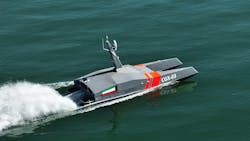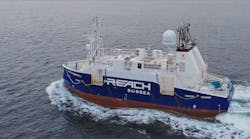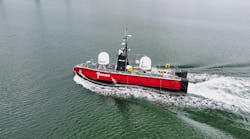Ocean Infinity launches NeedleFish USV in Kuwait
Marine robotics company Ocean Infinity says that it has successfully launched its NeedleFish Uncrewed Surface Vessel (USV) at an official event with the Kuwaiti Coast Guard (KCG).
Initiated to be a component of its new national integrated maritime surveillance system being delivered by SRT Marine Systems, Ocean Infinity says that the NeedleFish USV is custom equipped with an array of specialist maritime surveillance sensor systems, and leverages the company’s software, robotics, and marine intelligence technology systems.
Ocean Infinity says that these systems will equip the Kuwaiti Coast Guard with a new class of unmanned patrol, surveillance, mapping and surveying capability for its 11,000km² of territorial waters, all controlled from KCG’s new purpose-built onshore command centers and fully integrated within their new SRT C5iSR maritime surveillance system.
This, combined with the company’s understanding of data capture and transfer at sea, has led to a platform tailored for the client’s specific need in the demanding conditions offshore Kuwait, says Ocean Infinity. The USVs will help deliver beyond line-of-sight marine surveillance, with live surveillance streaming fully integrated into their new MDA System.
In early July, one of the KCG fleet of bespoke 14-meter, dual-hull NeedleFish USVs completed live demonstration exercises in open water in a special demonstration for Sheikh Fahad Yousef Saud Al-Sabah, First Deputy Prime Minister and Acting Minister of Interior, and Commodore Sheikh Mubarak, overall Commander of the Kuwait Coast Guard.


